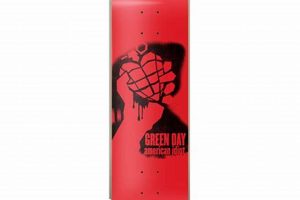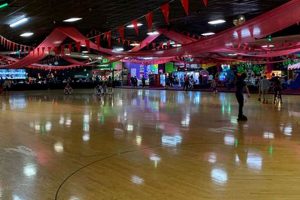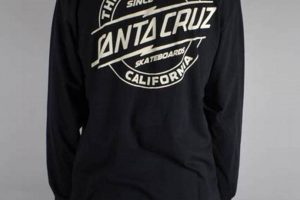Footwear specifically designed to accommodate a broader foot profile offers enhanced comfort and performance for individuals whose feet exceed standard width measurements. These specialized skates prioritize a wider toe box and overall increased volume, minimizing pressure points and preventing discomfort during use. For example, a hockey skate engineered with a wider last ensures proper blood circulation and reduces the risk of blisters and numbness.
The advantages of using correctly fitted skates are substantial. They promote improved balance, control, and power transfer, leading to a more efficient and enjoyable skating experience. Historically, skaters with wider feet often faced limitations in available options, leading to modifications or compromises in fit. However, advancements in manufacturing techniques have resulted in a wider range of models specifically catering to this need.
The following sections will delve into key considerations for selecting appropriate skates, including various types available, critical fitting characteristics, and essential factors for optimizing comfort and performance. This information is intended to provide comprehensive guidance for choosing skates that meet the unique requirements of wider foot profiles.
Guidance for Skates Suited to Broad Feet
Selecting skates that properly accommodate wider feet requires careful consideration to ensure optimal comfort and performance. The following guidelines outline essential aspects to evaluate when making a purchase.
Tip 1: Research Available Brands and Models: Not all skate manufacturers offer models specifically designed for wider feet. Researching brands known for accommodating a broader fit is a crucial first step. Look for product descriptions that explicitly state “wide fit” or “EE width.”
Tip 2: Prioritize Width Over Length: A common mistake is to compensate for width issues by selecting a longer skate. This can compromise control and stability. Focus on finding the correct width first and then adjust length if necessary.
Tip 3: Consult Size Charts Carefully: Skate size charts can vary significantly between manufacturers. Always consult the specific size chart for the brand and model being considered, paying close attention to width measurements.
Tip 4: Consider Heat Molding Options: Heat molding allows for customization of the skate boot’s shape, improving the overall fit and addressing specific pressure points. Not all skates are heat moldable, so confirm this feature before purchase if desired.
Tip 5: Pay Attention to Tongue Design: The skate tongue should sit comfortably against the foot and shin without causing pressure or irritation. A wider or more flexible tongue can improve overall comfort for individuals with broader feet.
Tip 6: Assess the Insole: The insole can significantly impact fit and comfort. Consider replacing the stock insole with a wider or more supportive option if needed. Aftermarket insoles designed for wider feet are readily available.
Tip 7: Seek Professional Fitting Advice: Consulting with a skate professional is highly recommended. They can assess foot dimensions, provide personalized recommendations, and ensure a proper fit.
Adhering to these guidelines will aid in selecting skates that offer superior comfort and performance for individuals requiring a wider fit, contributing to an enhanced and injury-free skating experience.
The subsequent sections will address specific types of skates and delve deeper into the fitting process, providing further insights into securing an optimal skate fit.
1. Accommodating Width
Accommodating width is a fundamental attribute of skates intended for individuals with wider foot profiles, directly influencing comfort, performance, and overall skating experience. The degree to which a skate effectively accommodates width dictates its suitability.
- Internal Volume Distribution
The distribution of internal volume within the skate boot is crucial. Skates designed for standard foot widths often taper significantly towards the toe, creating discomfort for wider feet. Skates that accommodate width feature a more uniform volume distribution, preventing pressure points and allowing for natural foot splay. This redistribution often includes a wider toe box and increased instep height.
- Last Shape and Construction
The “last,” the foot-shaped form around which a skate is constructed, is a primary determinant of fit. Skates designed for accommodating width utilize specific lasts that mirror the broader dimensions of wider feet. These lasts influence the overall shape of the boot, ensuring ample space throughout the foot’s length and width. Construction methods, such as strategic stitching and panel placement, further enhance the skate’s ability to conform to the foot’s unique shape.
- Material Flexibility and Adaptability
The materials used in skate construction play a significant role in accommodating width. Softer, more flexible materials, particularly in the forefoot area, allow the skate to adapt to the foot’s shape, minimizing pressure and friction. Heat-moldable materials offer a further level of customization, enabling the skater to personalize the fit for optimal comfort and performance. However, the material must also have rigidity for skating itself.
- Adjustability Features
Certain skate models incorporate adjustability features designed to enhance width accommodation. Lacing systems that allow for independent tightening of the forefoot and midfoot sections can fine-tune the fit. Additionally, some skates feature adjustable tongue positions or removable shims that allow for customized volume adjustment. These features provide a dynamic fit that can adapt to changes in foot volume during skating.
The interplay of internal volume, last shape, material flexibility, and adjustability features defines the effectiveness of width accommodation in skates. Selection requires careful evaluation of these elements to ensure a comfortable and high-performing skating experience for individuals with wider feet.
2. Reduced Pressure
The concept of reduced pressure is paramount when considering appropriate skates for wider feet. Ill-fitting skates can induce significant pressure points, leading to discomfort, pain, and potential long-term foot health issues. Proper skate selection directly mitigates these risks, contributing to an enhanced and more enjoyable skating experience.
- Enhanced Circulation
Excessive pressure restricts blood flow to the feet, potentially causing numbness, tingling, and even tissue damage. Skates designed for wider feet provide adequate space for circulation, preventing these adverse effects. By minimizing constriction, these skates promote healthy blood flow, ensuring the feet remain comfortable and functional for extended periods.
- Blister Prevention
Friction between the foot and the skate boot is a primary cause of blisters. Poorly fitted skates exacerbate this friction, increasing the likelihood of blister formation. Skates that accommodate wider feet minimize friction by providing a more natural fit, reducing the rubbing that leads to blisters. This is particularly important for long-distance skating or activities involving repetitive movements.
- Neuroma Mitigation
A neuroma, a thickened nerve tissue, can develop due to chronic compression. Tight skates can contribute to neuroma development or exacerbate existing conditions. Skates designed for wider feet alleviate pressure on the nerves in the foot, reducing the risk of neuroma formation and providing relief for individuals already suffering from this condition.
- Improved Alignment
Excessive pressure can force the foot into unnatural positions, leading to misalignment and potential problems in the ankles, knees, and hips. Properly fitted skates support the foot’s natural alignment, preventing these compensatory movements. By distributing pressure evenly across the foot, these skates contribute to overall biomechanical efficiency and reduced risk of injury.
In summary, reduced pressure is a critical benefit of selecting skates specifically designed for wider feet. By promoting circulation, preventing blisters, mitigating neuromas, and improving alignment, these skates contribute to foot health, comfort, and performance, ensuring a more positive and sustainable skating experience. The mitigation of pressure points through proper skate selection is therefore a key consideration for skaters with wider foot profiles.
3. Enhanced Stability
The correlation between stability and appropriately fitted skates is demonstrable, especially for individuals with broader foot dimensions. Stability, in the context of skating, encompasses the ability to maintain balance, control movements, and execute maneuvers with precision. Skates that fail to accommodate the width of the foot compromise stability by creating an unstable platform. The foot may shift within the boot, leading to inconsistent power transfer and increased risk of ankle roll or other instabilities. This effect is pronounced in activities requiring rapid changes in direction, such as hockey or roller derby. Conversely, skates designed with a wider last and appropriate internal volume provide a secure and stable base, enabling the skater to maintain balance and control with greater ease.
The improved stability afforded by properly fitted skates translates directly to enhanced performance and reduced injury risk. For example, a figure skater with wide feet may struggle to maintain edge control in standard skates, leading to imprecise jumps and landings. Equipping the skater with skates that conform to the foots dimensions can significantly improve edge control and stability, allowing for more consistent and confident execution of complex maneuvers. Similarly, a recreational skater with wider feet may experience ankle fatigue and discomfort due to the foot sliding within the skate. A wider skate, in this instance, provides better support and reduces the strain on the ankle, making longer skating sessions more comfortable and less prone to injury.
In summary, enhanced stability is not merely a desirable attribute but a fundamental requirement for effective and safe skating, particularly for those with broader feet. Selecting skates designed to accommodate wider foot dimensions is a critical step in optimizing balance, control, and performance, thereby reducing the likelihood of injury and maximizing the overall skating experience. The proper integration of width accommodation into the skate design directly influences the stability experienced by the skater.
4. Improved Performance
The correlation between appropriately fitted skates and improved performance is significant, particularly for individuals with wider feet. Ill-fitting skates, characterized by inadequate width, can impede performance by restricting foot movement, causing discomfort, and disrupting balance. Skaters may compensate for these issues by altering their technique, leading to inefficiencies and increased fatigue. Properly fitted skates, conversely, allow for natural foot movement, promoting efficient power transfer and enhanced control. This leads to improved speed, agility, and overall performance in various skating disciplines.
Consider the example of a speed skater with wider feet using skates that are too narrow. The restricted foot movement within the boot limits the skater’s ability to generate maximum power during each stride. The discomfort caused by pressure points distracts the skater, impacting concentration and coordination. By switching to skates specifically designed for wider feet, the skater experiences improved comfort, enhanced foot mobility, and more efficient power transfer, ultimately resulting in faster lap times and improved race performance. Similarly, in hockey, wider feet confined in standard skates can lead to decreased agility and compromised skating ability, affecting the player’s responsiveness and overall game performance. Good skates for wide feet increase the ability to achieve their peak performance.
In conclusion, the link between appropriately fitted skates and improved performance is undeniable. Skates tailored to accommodate wider feet eliminate discomfort, promote efficient foot movement, and enhance balance, leading to measurable improvements in speed, agility, and overall skating proficiency. The practical significance of this understanding lies in the recognition that proper fit is not merely a matter of comfort but a critical component for achieving peak performance in any skating discipline. Understanding these relations are important to know when finding good skates for wide feet.
5. Customization Options
Customization options are integral to achieving optimal fit and performance in skates, particularly for individuals with wider feet. Standard skate designs often fail to adequately address the unique contours and dimensions of wider foot profiles, necessitating adjustments to ensure comfort and functionality. The availability of customization features allows skaters to overcome these limitations, transforming an otherwise inadequate skate into a well-suited piece of equipment. For instance, heat-moldable boots can be shaped to accommodate bunions or other foot deformities, while aftermarket insoles can provide additional arch support or volume adjustment. The effectiveness of customization options directly impacts the overall satisfaction and performance of skaters with wider feet.
Common customization options include heat molding, insole replacement, and modifications to the lacing system. Heat molding, offered by many skate manufacturers, allows the boot to conform to the specific shape of the foot, alleviating pressure points and improving overall fit. Aftermarket insoles, available in a variety of shapes and materials, can provide additional arch support, correct pronation or supination, and adjust the volume within the skate boot. Modifications to the lacing system, such as using waxed laces or adjusting lacing patterns, can further fine-tune the fit, providing targeted support and pressure relief. These modifications often enhance the performance of the skates making them a good skates for wide feet.
In summary, customization options are not merely ancillary features but essential components of effective skate fitting for individuals with wider feet. These features enable skaters to overcome the limitations of standard designs, achieve optimal comfort and performance, and prevent potential foot-related injuries. The availability and proper utilization of customization options are, therefore, critical factors in the selection of skates for skaters with wider foot profiles, making the skates good skates for wide feet. The ability to adapt and personalize skate fit is a key determinant of overall skating experience and long-term foot health.
Frequently Asked Questions
This section addresses common inquiries concerning the selection and fitting of skates designed to accommodate wider foot profiles. The information provided aims to clarify key considerations and dispel potential misconceptions.
Question 1: Are skates specifically designed for wider feet truly necessary, or can standard skates be adequately adjusted?
While minor adjustments to standard skates, such as heat molding or insole modifications, can improve fit, they rarely provide the optimal comfort and performance afforded by skates specifically designed for wider feet. These specialized skates incorporate wider lasts and increased internal volume, addressing the fundamental fit requirements that standard skates often cannot accommodate.
Question 2: What width designation should be sought when purchasing skates for wider feet?
Width designations can vary between manufacturers. However, “EE” or “Wide” are commonly used to indicate a wider fit. Consulting the specific manufacturer’s size chart, which includes width measurements, is essential for accurate selection.
Question 3: How can one determine if a skate is truly wide enough without physically trying it on?
While physical try-on is ideal, detailed product descriptions, including specifications on width and last type, can provide valuable information. Additionally, reviewing customer feedback and seeking recommendations from skate professionals can assist in making an informed decision.
Question 4: Do skates designed for wider feet require a longer break-in period compared to standard skates?
The break-in period can vary depending on the materials and construction of the skate. However, properly fitted skates, regardless of width, should not require an excessively long or painful break-in period. Significant discomfort during break-in suggests an improper fit.
Question 5: Are there specific skate types (e.g., hockey, figure, recreational) that are more readily available in wider widths?
Availability varies by manufacturer and model year. However, some brands are known for offering wider options across different skate types. Researching specific brands and their offerings is recommended.
Question 6: Can aftermarket insoles effectively compensate for a skate that is slightly too narrow?
Aftermarket insoles can improve comfort and support, but they cannot fundamentally alter the width of the skate boot. Insoles are best used to fine-tune the fit of a skate that is already appropriately sized in width, rather than as a primary solution for inadequate width accommodation. Good skates for wide feet are preferred in the end.
In conclusion, careful consideration of width specifications, consulting size charts, and seeking professional advice are crucial steps in selecting skates that provide optimal comfort and performance for individuals with wider feet. Addressing the specific needs of wider foot profiles ensures a more enjoyable and injury-free skating experience.
The subsequent section will provide a summary of key considerations for selecting skates tailored to wider feet, reinforcing the importance of proper fit and its impact on overall skating performance.
Selecting Appropriate Skates for Broad Feet
This exploration has emphasized the critical importance of selecting footwear that properly accommodates wider foot profiles. Key considerations include prioritizing width over length, consulting manufacturer size charts, and, ideally, seeking professional fitting advice. Skates designed specifically for wider feet offer enhanced comfort, stability, and performance compared to standard models, minimizing pressure points and reducing the risk of injury.
Ultimately, the selection of suitable skates for broader feet is an investment in both performance and long-term foot health. Skaters are encouraged to prioritize a proper fit to maximize their skating experience and mitigate potential discomfort or injury. Further research and careful evaluation of available options will contribute to informed decision-making, ensuring that selected skates meet individual needs and preferences, enhancing both the enjoyment and longevity of the skating pursuit.







